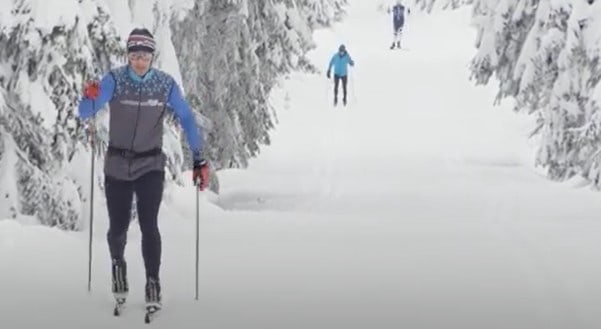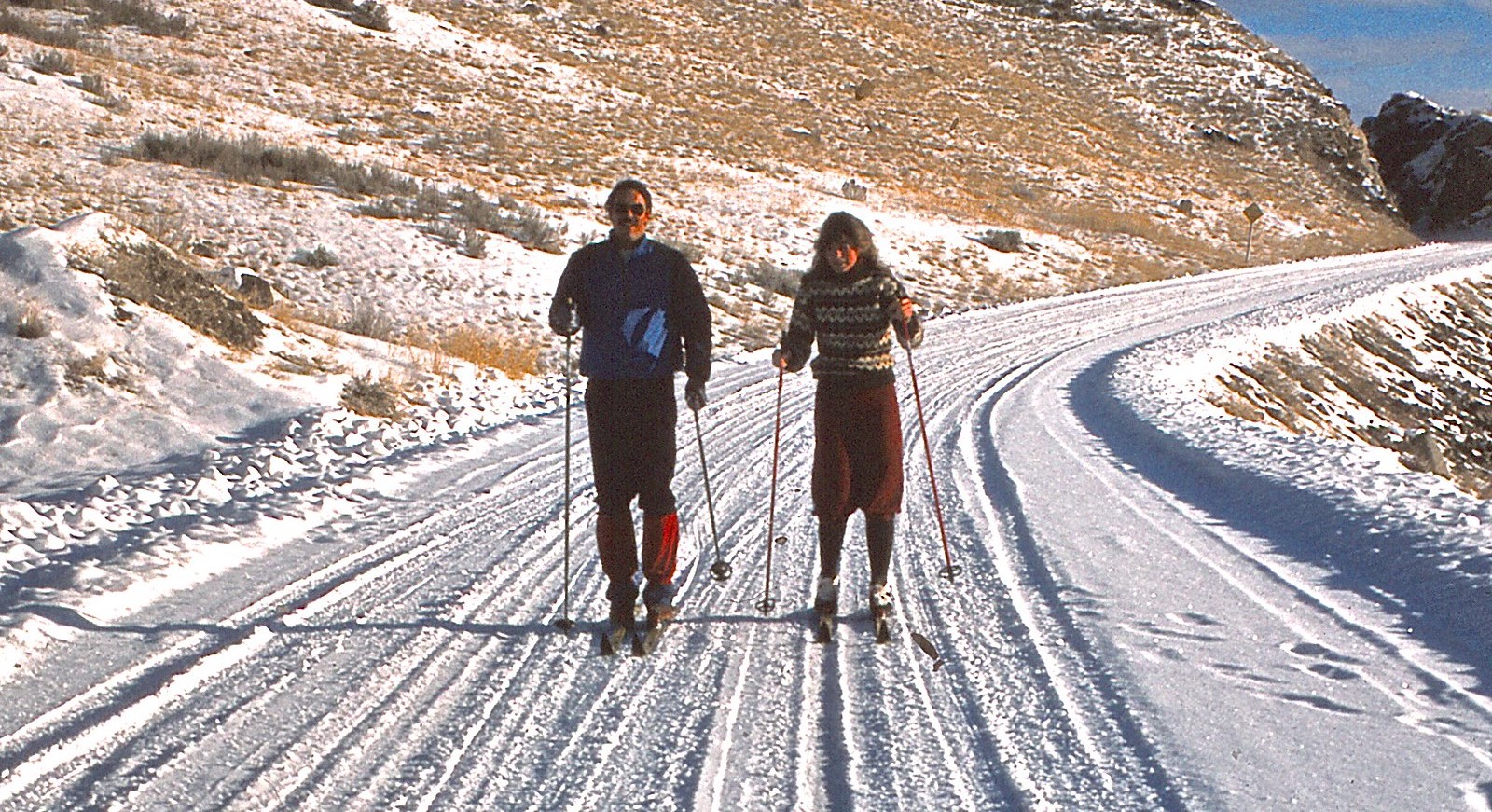Last updated on January 29th, 2023 at 09:46 am
If you live where the seasons change you may be lucky enough to take on cross country skiing this winter. For those of us more focused on running there is an intimidating curiosity around cross country skiing. In this post, we explore cross country skiing vs running in an attempt to shed light on their similarities and differences.
Cross Country Skiing vs Running Video
After Sarah and I went cross-country skiing last winter, we decided to make a video comparing running and cross country skiing.
Check out the video below, and then if you want more detail, check out the rest of the post.
Briefly Defining Each Sport
Before we compare and contrast the two sports it is important we define them.
Cross Country Skiing: Cross country skiing is the act of propelling oneself forward over snow-covered terrain using repetitive arm and leg movements via the aid of ski poles and skis. This form of skiing does not rely on gravity for movement.
Running: Running is a rapid form of land based movement whereby locomotion is fast enough for both feet to be in movement about ground at the same time.
Cross Country Skiing and Running Similarities
On the surface, cross country skiing and running don’t appear to hold many similarities.
If you can look past the additional equipment requirements that come with cross country skiing you may realize the two sports have more in common than you think.
Below are the most prominent similarities between the two activities.
1. Cross Country Skiing and Running are Both Great Aerobic Activities
Cross country skiing and running are both aerobic activities. What this means is both cross county skiing and running require large loads of oxygen, which results in an increased heart rate and cardiovascular conditioning.
This makes cross country skiing a great cross training activity for trail and road runners alike. You can read about ten cross training activities for trail runners in our post on the topic.
Cross country skiing and running activities can be executed at low or high intensities and at varying duration’s; all will require increased oxygen and additional work from your heart.
2. Both sports Ideal for Short and Long Distances
When it comes to aerobic activities some of us seem to prefer the sprint, while others seek the distance.
Cross Country Skiing and Running have space for BOTH enthusiasts in the sport.
Sprinting and Competitions
The most prevalent example of sprinting can be seen every four years during the Olympics, as some of the most popular events involve sprinting. The 100 meter dash comes to mind.

As with running, cross country skiing has an entire sect of die-hards focused on moving very fast over relatively short distances. The Olympics even added the Individual Sprint to its competitions in 2002. The individual sprint competition for for cross country skiing is 1400 meters.
Long Distance
Runners and cross country skiers can both put together impressive displays of endurance.
Marathons are the most commonly referenced long distance running event at 26.2 miles (42.16 kilometers).
Similarly impressive distances can be covered by cross country skiers. Cross country skiing marathons are approximately 25 miles (40 kilometers).
3. Fantastic Core Workouts
Running and cross country skiing are both fantastic core workouts. The requirement for stabilization in each activity ensures that abdominal, lumbar, oblique, and glute muscles engage and strengthen.
Differences Between Cross Country Skiing and Running
No matter how many similarities there are between running and cross country skiing they are clearly unique. Below we outline some of the major ways cross country skiing and running differ.
1. Equipment Requirements
The most obvious difference separating cross country skiing and running is the required equipment. One simple glance at a cross country skier would make this clear.
While running requires only running shoes to get moving, cross country skiing has five essential pieces of equipment that are needed. In addition to cold weather athletic wear every cross country skier will need:
- Cross Country Skies: The main piece of equipment that your feet lock into; used for gliding on snow and ice.
- Ski Boots: Your feet go in these, and they are designed to easily snap into your skis. Without these your skis would be useless.
- Ski Poles: Each hand will be holding one of these, and the opposite end is used to assist in propelling you forward.
- Ski Goggles: It is going to be cold and blistery out there, and you are going to need to keep your eyes open. Ski goggles help.
While the above list of equipment can be daunting it really is just the beginning when it comes to cross country skiing. Hats, leggings, backpacks, and upper wear that keeps you warm without sweating too much are all going to be needed.
2. Upper Body Used Significantly
Aside from the back and forth arm movements experienced while running, there isn’t much arm effort required during a run.
Cross country skiing couldn’t be further from running in terms of arm movement; a ton of upper body strength is needed. Ski poles are used for a reason.

And if you are going to be skiing up a hill, even at a slight incline, you are going to be feverishly using your ski poles (and arms and chest) to make it to the top.
Specifically because of the upper body effort required, there has been a lot of research looking into upper body strength training for cross country skiers. The Norwegian School of Sport Sciences even made note of improvements in cross country results when upper body muscular endurance training is incorporated.
Don’t get me wrong, you don’t need to be a body builder to be a successful cross country skier. You do, however, need to be ready to have your entire body engaged in the activity.
3. Moving Uphill is Very Difficult
The uphill portion of running can be grueling, but going uphill while cross country skiing is hugely difficult.
Moving uphill with cross country skis on requires a method referred to as the Herringbone Technique: Arranging your skis in a “V” shape to start, and pushing outward to propel yourself forward. The tips of your skis will be pointing away from each other, and your poles will be on the outside of your skis.
Moving uphill at any pace in skis will require you to engage your entire body, and will result in a rapid increase in heart rate.
Yes, running uphill is also going to increase your heart rate, but you are using less of your body to move up that hill. As a result uphill movement take much more effort when skiing.
4. Finding Suitable Trails
With running, for the most part, the world is your trail. For much of the world even the winter months are approachable for running.
Simply dress appropriately, find a running trail, and start running. Bridal trails are specifically good for winter trail running.
For cross country skiing it can be much more difficult to locate a suitable snow covered trail. This can be especially true for those of us living in urban environments.
Ideal Cross Country Skiing Trails
Finding relatively flat locations would be a good starting spot for beginners. Public park lands with large lawn areas can be ideal. Golf courses also tend to be great cross country skiing trails, although these are often private and inaccessible.
Following a good snow bridal trails may also be good trails for cross country skiing. It should be noted that the fewer foot depressions in the snow the better your skiing experience so get out there right after the snow falls.
5. Seasonality
Unlike running, cross country skiing is a true seasonal sport. Snow is a prerequisite for a successful trail excursion. While most places on earth experience some form of season change, not all locations receive snow fall. I know…how sad!
Even climates that get cold can have years with varying levels of snowfall. This can make some seasons less fruitful than others.
Yes, there is special equipment out there to help die-hard skiers hone their craft on solid ground. But this equipment is not the same as true skiing; it is simply mimicking the movements and cardiovascular workout one gets on the trails.
Cross Training Is Good: Ski
Regardless of your chosen activity it is proven that cross training is beneficial. Reducing the long term focused stress of one type of repetitive movement will help maintain your longevity. Cross training also has the potential to help you improve your efforts in your primary activity.
If you are a runner in a climate that experiences season change I would strongly recommend spending some time this winter on skis. Snow presents some general challenges to trail running so why not mix in an activity designed to work perfectly in the snow.
Get On Cross Country Skis Already
If you aren’t ready to make the plunge and purchase a ton of skiing gear, no worries. There tend to be rental opportunities where the snow falls. Renting cross country skiing equipment is a low risk way to gain some experience on the snow to see if cross country skiing is right for you.
Image Credit: Pat Strosahl | (https://www.flickr.com/photos/pat_strosahl/) | Attribution-ShareAlike 2.0 Generic (CC BY-SA 2.0)

